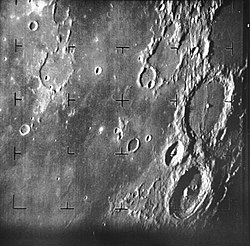Ranger program
The Ranger were the first US probes, developed in 1960 by the Jet Propulsion Laboratory (JPL). Its main objective was to photograph the Moon to obtain information about the characteristics of the lunar surface, with a view to the development of the Surveyor and Apollo programs.
Directed by JPL employees in coordination with NASA. However, the failures of the project gave rise to a distance between both entities.
The launch vehicle was an Atlas-Agena B type rocket. 9 probes were launched, of which only Ranger 7, 8 and 9 obtained positive results.
Ranger Missions
Ranger 1
Release date: August 23, 1961
Completion date: August 30, 1961
Mass: 306 kg
Mission: Test the vehicle and measure twilight radiation. It failed to restart and entered a very low orbit of 169 × 504 km: after 111 orbits it fell to Earth.
Ranger 2
Release date: November 18, 1961
Completion date: November 20, 1961
Mass: 306 kg
Mission: Repeated tests for the study of space in lunar and interplanetary missions. The rocket failed, so it entered too low an Earth orbit of 153 × 235 km. He soon fell to Earth. First lunar probe with solar cells.
Ranger 3
Release date: January 26, 1962
Mass: 330 kg
Mission: Probe with telecamera to photograph the Moon in fall; but the signal from him was too weak. Due to excessive acceleration, it passed within 36,792 km of the Moon. It entered solar orbit, with a period of 406.4 days.
Ranger 4
Release date: April 23, 1962
Completion date: April 26, 1962
Mass: 331 kg
Mission: Same objectives as its predecessors. After entering parking orbit, she was placed on a lunar trajectory. The camera didn't work. After a programmer failure, it crashed on the far side, southwest of Ioffe crater, at 15.5° S and 130.7° W, being the first US probe to hit the Moon.
Ranger 5
Release date: October 18, 1962
Mass: 342 kg
Mission: After entering parking orbit, its solar cells failed. It passed 724 km from the Moon and entered a solar orbit, with a period of 366 days.
Ranger 6
Release date: January 30, 1964
Mass: 365 kg
Mission dedicated to photographing the Moon. Upon receiving the operating order, its six cameras failed. It crashed into the Moon in the Sea of Tranquility at 0.2°N and 21.5°E.
Ranger 7
Release date: July 28, 1964
Completion date: July 31, 1964
Mass: 365.71 kg
Mission: the first photographs sent by an American probe of the visible side of the Moon. Before crashing in the vicinity of Bonpland crater (at 10.7° S and 20.7° W), between 2,100 and 480 meters it sent 4,316 images, with details as small as 38 cm.
Ranger 8
Release date: February 17, 1965
Completion date: February 20, 1965
Mass: 367 kg
Mission: Similar objectives to the previous ones. Before crashing into the Moon at a speed of 9,656 km/h in the Sea of Tranquility (at 2.7° N and 24.8° E), it sent back 7,137 images.
Ranger 9
Release date: March 21, 1965
Completion date: March 24, 1965
Mass: 366 kg
Mission: Last probe of the program. Before impacting the Moon ―near the Alfonso crater (at 12.9° S and 2.4° W)― it obtained 5814 images, 200 direct transmission. It showed that the Moon is subjected to continuous bombardment by micrometeorites.
Contenido relacionado
Aeschylus
Alexander I (pope)
Persecution of Christians



